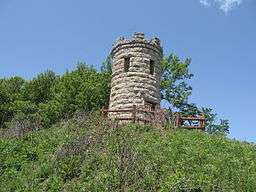Julien Dubuque

Julien Dubuque (January 1762 – 24 March 1810) was a French Canadian of Norman origins[1][2] from the area of Champlain, Quebec who arrived near what now is known as Dubuque, Iowa – which was named after him. He was one of the first European men to settle in the area. He initially received permission from the Meskwaki Indian tribe to mine the lead in 1788. Subsequently the Spanish confirmed that by giving him a land grant in 1796.
Once he had received permission from the Meskwaki to mine lead, Dubuque remained in the area for the rest of his life. He befriended the local Meskwaki chief Peosta – for whom the nearby town of Peosta, Iowa is named. It is widely believed that Dubuque married Peosta's daughter, who was supposedly named "Potosa"; however, there is no evidence that this was ever the case. Those who back the marriage claim point to letters that mention a Madame Dubuque as meaning Dubuque's wife.
After his death, the Meskwaki built a log crypt for Dubuque, which was replaced in the late 19th century by an imposing stone monument.
The name "Potosa" often appears in fanciful origin stories for the name Potosi, a small Wisconsin town located north of Dubuque, Iowa, which was founded in the 1830s as a lead-mining settlement.
Legacy

Dubuque is remembered as the first European to settle in what would become the state of Iowa. He is remembered as a friend of the Native Americans in the area and a champion of their cause. Dubuque was also a generous man who spent lavishly on many friends - this had the unfortunate effect of keeping him in debt during the later part of his life.
When what would eventually become Iowa was opened up to European settlement, the settlement in the area where he had mined was named after him. It was known by several names, including DuBuque's Mines. Eventually, the village became the first city in Iowa, and was named Dubuque in memory of Julien Dubuque. Dubuque's resting place and memorial lie on a cliff facing the Mississippi river at the Julien Dubuque Monument in the Mines of Spain State Recreation Area and E. B. Lyons Nature Center.
Dubuque facial reconstruction

In 2012, members of the Dubuque County Historical Society and curators at the National Mississippi River Museum asked forensic artist Karen T. Taylor to create a facial reconstruction based on the skull of Dubuque. Upon his death in 1810, he was buried on a high bluff overlooking the Mississippi River. In the late 1800s, the original log mausoleum was replaced by the limestone tower and monument at the same site. At that time, excellent photographs were made of Dubuque's skull prior to reburial. Though Dubuque's actual skull now lies buried under many feet of concrete, Taylor was able to use the multiple 1887 photographs, along with historic and anthropological inputs to create a reasonable depiction of his appearance in life. The facial reconstruction images are on display at the National Mississippi River Museum & Aquarium in Dubuque, Iowa.
Gallery
-

Dubuque's gravesite
-
.jpg)
Dubuque's gravesite, 1897
-

An artist's conception of Dubuque
-

Chief Peosta's gravesite
Legacy
Julien Dubuque is the namesake of Dubuque, Iowa and Dubuque County, Iowa.[3]
Notes
- ↑ Tassé, Joseph (1878). Les canadiens de l'ouest.
- ↑ Tassé, Joseph (1871). Revue Canadienne, Volume 8. E. Senécal. p. 241.
- ↑ Gannett, Henry (1905). The Origin of Certain Place Names in the United States. Govt. Print. Off. p. 109.